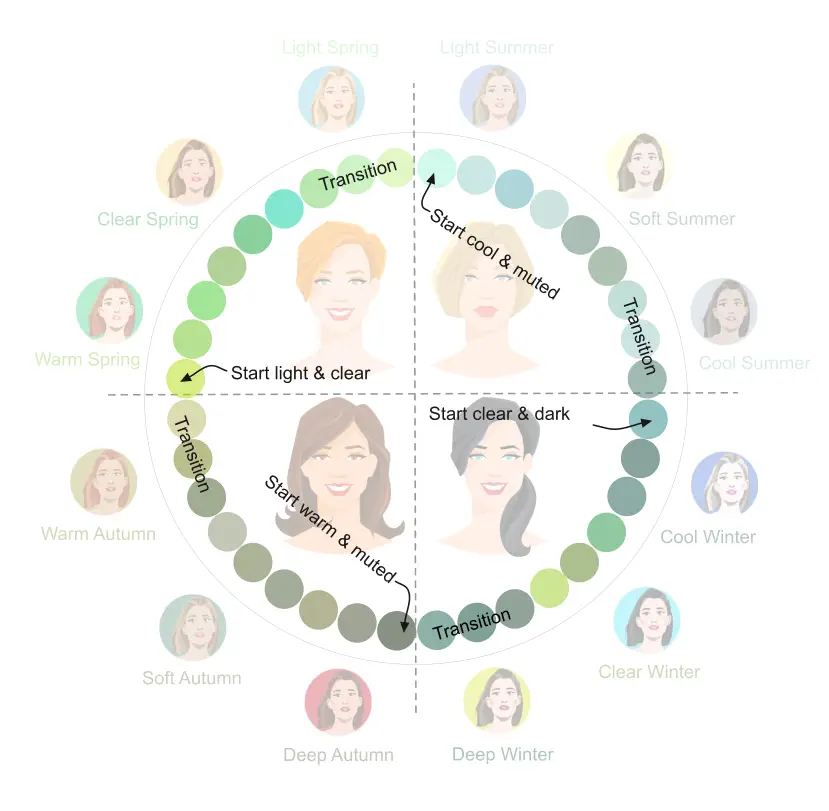Only rarely does someone fit exactly into the picture of a color type of the four seasons system. This is where the 12 seasons system comes into play: for example, if you have found out that you should be a summer type, but your skin has neither a cool nor a warm undertone, or the cool undertone is there, but your hair does not always look ashy, but shimmers slightly reddish or golden in the sun, then you could be a soft summer type – a mixed type between summer and autumn. The main criterion here would be that only muted colors suit you.
If you are not sure which color type you are, please book my online course for your DIY Color Analysis.
How the 12 seasonal Color System works:
The 12 Seasonal Color System divides the 4 basic types into 3 color types each, resulting in a total of 12 season types.
The basic types are each divided into three subtypes. The following properties are used for classification: Clear, Cool, Deep, Light, Soft and Warm.
- Clear: Clear colors are assigned to this type. Whether light or dark, warm or cold. The Clear type can be found as Clear Winter and Clear Spring.
- Soft (Soft/Muted): Generally muted colors, whether light or dark, warm or cold. The Soft type is available as Soft Summer and Soft Autumn.
- Cool (Cold): Generally cold colors, whether light or dark, clear or muted. The Cool type can be found as Cool Winter and Cool Summer.
- Warm: Warm colors, whether light or dark, clear or muted. The Warm type is available as Warm Autumn and Warm Spring.
- Deep (Deep/Dark): Generally dark colors, whether warm or cold, clear or muted. The Deep type can be found as Deep Winter and Deep Autumn.
- Light: Light colors, whether warm or cold, clear or muted. The Light type is available as Light Summer and Light Spring.
Info
There are also different designations and approaches in the 12-Seasonal Color System. For example, you will often find “Bright” instead of “Clear” and “Dark” instead of “Deep”. Likewise, the respective season is sometimes referred to as “True” instead of “Cool” and “Warm”. This classification usually assumes that the “True” season is the basic season of spring, summer, fall or winter. The subtypes Clear, Soft, Deep and Light are regarded as mixed types. This is why the seasons wheel looks different in the “True” system.
Why I favor this 12 Seasonal System:
So why this 12 season system and not the other one? The True system is based on the main criteria of warm & cold. In my opinion, the statement “Autumn is a warm season” is far too inaccurate. If you take a look at the seasonal wheel, you’ll see that fall is on the warm side, but also in the dark half. Its quarter is also muted. Therefore, for me, the “true” autumn is the one that fulfills most of the autumn criteria in this order:
Deep Autumn (warm, dark, muted), whereas Warm Autumn fulfills the “dark” criterion the least of the 3 autumn types.
Winter is on the cool side, in the dark half and its quarter is clear. Cold, dark and clear is best fulfilled by Cool Winter.
Summer is also on the cool side, but in the light half – and its quarter is muted. Light Summer fulfills all these criteria (cold, light, subdued).
Spring shares the warm side with Autumn, it is in the light half and its quarter is clear. Warm Spring best fulfills all these criteria.
So you can see that the term “true” for the criteria warm & cold would only apply to Cool Winter and Warm Spring.
Why is that?
In the circle of seasons, the change of criteria always starts clockwise at the beginning of a quarter. The respective ends of the quarters drift a little into the next criterion.

Info
Based on my experience, the 12-season system is best applied and seen as a standalone system. There’s no “real” spring, summer, autumn, or winter, each with two mixed types. Rather, the designations can be taken literally. So, for example, there’s the cool, the dark, and the clear winter types. Generally, there’s a “best fitting” type for everyone. However, that doesn’t mean that everyone has exactly the characteristics that belong to that type. For instance, a Deep Winter might be slightly clearer or cooler than average. A Clear Winter might be slightly warmer than typical, and the pink tones of the palette might not suit them so well. Or conversely, they might be cooler and the red tones don’t flatter them as much. If you’re such a “color type with atypical features”, it can be difficult to determine your color type on your own. In that case, feel free to book my online course DIY seasonal color analysis. It will help you!
The seasonal color wheel and the color types in the 12 Seasonal Color System
To better understand the system, let’s take a closer look at the seasons wheel using the color green as an example. Here I explain the basic characteristics of the 6 subtypes. Click on the images to get a detailed description of the respective color type.
The clear and soft types are each diagonal to each other on the circle. This is simply because with 12 color types, the 3 main criteria (temperature, brightness and saturation) must be divided up regularly and in relation to each other on a circle. The “saturation” criterion can be found in the quarter circles and determines the clear and soft types, which is why they are diagonal to each other.
We call color types with the same main criteria “sister types”. They always come from different seasons and are next to each other on the seasons wheel or, in the case of the clear and soft types, diagonal to each other. Each color type tilts a little towards its sister type in terms of its appearance. The common characteristics of the respective seasons are thereby strengthened, while the opposing characteristics are weakened a little.
- Clear: Winter and spring, as opposite seasons, have the clarity of their colors in common. This characteristic is reinforced in their sister types, which is why Clear types do not look good in muted colors. The opposing characteristics of cold-warm and dark-light are somewhat weakened, so that Clear Winter can wear lighter blue and yellow – as long as yellow is not the main color. Clear Spring can also tolerate darker purple and cooler blue. Clear types usually have a great contrast between hair, skin and eyes, their eyes are clear with pronounced whites. Clear blue, ice blue, turquoise blue or green, or emerald to amber.
- Soft: Summer and autumn, as opposite seasons, have the muted colors in common. This similarity is reinforced in their sister types. This is why Soft types tend to look unflattering in clear colors. The opposites of warm-cold and light-dark are somewhat weakened. For example, Soft Summer can wear dark berry tones. Soft types have very little contrast between eyes, hair and skin color. Often neither cold nor warm dominates as an undertone of skin and hair. The eyes are gray-green, gray-blue, blue, brown or hazel eyes.

The different color types of Light, Cool, Deep and Warm are located right next to each other on the seasons wheel.
- Light: As the name suggests, light types have light skin, hair and eyes. The hair color can be all variations up to light ash brown. The eye color is also very light, even a light brown is possible. Spring and summer have light colors in common, which is intensified in the sister types Light Spring and Light Summer. Warm-cold and clear-muted cancel each other out a little, so that the Light Spring can also wear colors with a higher proportion of blue, while the Light Summer wears a pale, not too warm yellow.
- Deep: Dark hair and dark eyes are characteristic of the Deep types, the skin tone can vary. The hair colors range from chestnut brown to black in all variations, dark amber is also possible. The eye color is also dark (black-brown, dark brown, medium brown, dark hazel eyes or dark green) but a dark blue is also possible if it is not very clear or sparkling. The dark colors reinforce each other, warm-cold and clear-muted cancel each other out a little. The Deep Winter type can also wear wine red, the Deep Autumn dark blue and not too cold turquoise.
- Warm: Types with “Warm” as the main characteristic have a warm (red or golden) tone in their skin and hair. The hair colors range from golden red and amber to strawberry blonde and medium chestnut brown. Warm medium brown, topaz, light hazel eyes and olive green are the eye colors. In these sister types, the warm characteristic is reinforced. Cold colors are therefore excluded for Warm Autumn and Warm Spring. Dark-light and muted-clear weaken each other a little, which is why the Warm Autumn can also wear lighter, warm green and beige tones. The Sarm Spring, on the other hand, has the darkest red tones of the spring palette.
- Cool: Cool types generally have no warm undertones in their skin, hair and eyes. Sometimes skin or eyes can be more neutral and cool. But never both. The skin color can be dark or light, the hair color black-blue, medium or dark ash-brown, silver-blonde or salt-and-pepper (for gray hair). The eye colors have a relatively small spectrum of dark brown, cool hazel eyes, black-gray and gray to gray-blue. These sister types also reinforce the main characteristic “cold” and generally do not tolerate real red.
Do you find it difficult to assign yourself to a main criterion? Not sure about your hair, skin, or eye color?
Here’s my help page for determining your color type.
Overview of the 12 Seasonal Color Types
Here you can find the individual 12 season types with short descriptions in a blog post.











